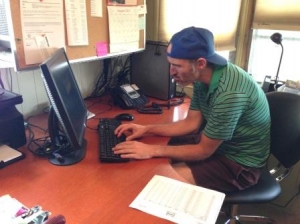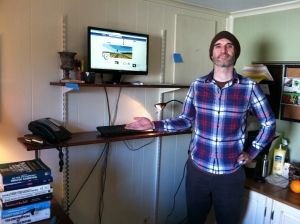How to Make a Stand.
 In the fall of 2012 something radical happened in the Blue Moon sales office: Rebecca and I threw our chairs out the window. Well, okay: we didn’t actually throw our chairs anywhere, but we did push them to the far side of the office. It was something we’d often fantasized about—instead of sitting while working, standing. Every other day it seemed another major media outlet was sounding the alarm over the health hazards associated with prolonged sitting. We decided it was time for a change.
In the fall of 2012 something radical happened in the Blue Moon sales office: Rebecca and I threw our chairs out the window. Well, okay: we didn’t actually throw our chairs anywhere, but we did push them to the far side of the office. It was something we’d often fantasized about—instead of sitting while working, standing. Every other day it seemed another major media outlet was sounding the alarm over the health hazards associated with prolonged sitting. We decided it was time for a change.
The history of the chair, and sitting more generally, is a revealing one. Only after the 16th century did what we know as the modern chair become common anywhere; prior to that, most folks, if they did sit, did so on benches or stools. Though really it wasn’t until the Industrial Revolution that the chair achieved the near-universal ubiquity with which we Westerners now associate it. Whereas in ancient times it had been a means for ruling classes to convey superiority over their subordinates (think thrones or sedans), the chair was now an indispensible part of daily life. Desks were designed around the chair, as were dining tables. Churches, concert halls, and town halls all required sitting in some type of chair. Colin McSwiggen, writing for Jacobin Magazine, points out that, “as chairs became prevalent in schoolrooms, they became a tool for teachers to control the movement of children, whose healthy tendency towards activity made them difficult to teach.” The chair was changing who we were as people, and not always for the best.
Indeed, recent research shows that prolonged sitting has lead to a number of health problems, including obesity and something called ‘metabolic syndrome’, a cluster of conditions including increased blood pressure, high blood sugar, abnormal cholesterol levels, and, yes, even larger posteriors. Sitting also raises the risk of death from cancer and cardiovascular disease. None of which, experts agree, can be offset by extra time at the gym. The only solution is to spend less time sitting.
Having worked for years in standing-intensive retail jobs, Rebecca and I knew we were physically capable of ditching our chairs, but just how was unclear. There was no shortage of standing desks on the market, but they were expensive and didn’t jive with our aesthetic. So we enlisted the help of Blue Moon handymen Carl Ruppert and “Uncle Jim” Rappo to design and build a pair of standing desks which were at once functional and attractive.
To be sure, the transition was not an easy one—several weeks had to pass before our legs adapted—but we knew right away we’d made the right decision. The chronic pain in my neck decreased, and I felt more limber, alert. Rebecca reported similar results. What’s more, standing made us feel in control, as though instead of reacting to the day’s events, we were enacting them. The only downside was the steady stream of confused glances and perplexed comments leveled by coworkers and visitors. One of our crew-members even asked if Jim and Kathy were making us stand. We soon learned that these were teachable moments—Did you know that sitting 11 hours a day raises by forty percent your risk of dying over the next three years? And little by little perceptions began to change.
Since we abandoned our chairs, the standing desk has seen its status as Hottest New Trend trumped by the ‘walking desk’, an upright workstation with a treadmill. All over the world, people are giving their chairs a rest. What about you? Are you ready to make a stand?


Can you be more specific about the content of your article? After reading it, I still have some doubts. Hope you can help me.
I don’t think the title of your article matches the content lol. Just kidding, mainly because I had some doubts after reading the article.
Your article helped me a lot, is there any more related content? Thanks!
Your point of view caught my eye and was very interesting. Thanks. I have a question for you.
I don’t think the title of your article matches the content lol. Just kidding, mainly because I had some doubts after reading the article.
Your point of view caught my eye and was very interesting. Thanks. I have a question for you.
Can you be more specific about the content of your article? After reading it, I still have some doubts. Hope you can help me.
I don’t think the title of your article matches the content lol. Just kidding, mainly because I had some doubts after reading the article.
Your article helped me a lot, is there any more related content? Thanks!
Your point of view caught my eye and was very interesting. Thanks. I have a question for you.
https://api.lioleo.edu.vn/public/images/course/4.png.php?id=slot-888-bet
https://lioleo.edu.vn/creatorcourse01/4.png.php?id=bet-max
Your point of view caught my eye and was very interesting. Thanks. I have a question for you.
24 Horas de Suporte Profissional: [brapub](https://www.brapub-br.com) Está Sempre Disponível para Você!
[pixbet](https://pixbet-88.com): O Aplicativo Ideal para Jogar Cassino com Uma Interface Incrível e Ótima Performance
ดาวน์โหลดแอป w69 – https://rebe0.com ได้ง่ายๆ เพียงไม่กี่ขั้นตอน พร้อมรับโบนัสต้อนรับ 100$ สนุกกับการเดิมพันที่ดีที่สุดบนมือถือ
สนุกกับการเดิมพันออนไลน์ที่ 188bet – https://188bet-778.com พร้อมข้อเสนอสุดพิเศษสำหรับสมาชิกใหม่ เพียงลงทะเบียนและเปิดบัญชีใหม่ รับโบนัสฟรี 100$ ทันที ใช้เล่นได้กับทุกเกม ไม่ว่าจะเป็นกีฬา คาสิโน หรือสล็อต เพลิดเพลินกับอัตราต่อรองที่ดีที่สุด และโปรโมชั่นสุดคุ้มตลอดทั้งเดือน ฝาก-ถอนสะดวกด้วยระบบออโต้ที่ปลอดภัย สมัครวันนี้เพื่อรับโบนัสและเริ่มสนุกได้ทันที!
Thank you for your sharing. I am worried that I lack creative ideas. It is your article that makes me full of hope. Thank you. But, I have a question, can you help me? https://accounts.binance.com/ru-UA/register-person?ref=OMM3XK51
https://gvis.tramandai.rs.gov.br/web-console/Cities/?id=56x-bet
http://hornoscasaemilio-valoriani.com/br/index.php?id=jp678-bet
http://pribehyfotek.cz/br/index.php?id=slot-bima-bet
http://sila-zerna.com/br/index.php?id=casino-bet
ใช้แอป 239 – https://oho16.com เพื่อเดิมพันการแข่งขัน Pokémon Unite และ Splatoon 3 พร้อมตัวเลือกเดิมพันแบบแฟนตาซีลีก สนุกไปกับการวิเคราะห์ทีมและกลยุทธ์แบบลึกซึ้งเพื่อคว้ารางวัลสุดพิเศษ
http://xn--l1acbdfo1f.xn--p1ai/br/index.php?id=asian-bet
Hi there just wanted to give you a quick heads up. The text in your post seem to be running off the screen in Ie. I’m not sure if this is a formatting issue or something to do with web browser compatibility but I thought I’d post to let you know. The design look great though! Hope you get the issue solved soon. Kudos
Your point of view caught my eye and was very interesting. Thanks. I have a question for you.
75r88 – https://vquf9.com อัปเดตแอปใหม่ให้รองรับการเดิมพันแบบเรียลไทม์ เชียร์ทีมโปรดของคุณได้แบบไม่มีสะดุด
Howdy very cool web site!! Man .. Excellent .. Wonderful .. I’ll bookmark your website and take the feeds also? I’m satisfied to search out a lot of helpful info here within the post, we’d like work out extra strategies on this regard, thank you for sharing. . . . . .
Your article helped me a lot, is there any more related content? Thanks!
I think what you published was actually very reasonable. But, what about this? what if you added a little content? I mean, I don’t want to tell you how to run your website, however suppose you added something that makes people desire more? I mean BLOG_TITLE is kinda vanilla. You might peek at Yahoo’s home page and watch how they create news headlines to grab viewers to open the links. You might add a related video or a picture or two to grab people excited about everything’ve got to say. Just my opinion, it could bring your website a little livelier.
I don’t think the title of your article matches the content lol. Just kidding, mainly because I had some doubts after reading the article.
futebol ao vivo -(https://vck2ws73.com)
Ganhe Agora com os Jogos do Cassino nine casino!
Ganhe Agora com os Jogos do Cassino nine casino!
awesome
Your article helped me a lot, is there any more related content? Thanks!
I don’t think the title of your article matches the content lol. Just kidding, mainly because I had some doubts after reading the article.
I don’t think the title of your article matches the content lol. Just kidding, mainly because I had some doubts after reading the article.
http://401drivingschool.com/media/aloh.php?candi=bambu+da+sorte
http://401drivingschool.com/media/aloh.php?candi=palpite+para+federal+hoje
https://aloh.in/wp-content/docs/?candi=suribet
http://antona-et-cofi.com/aloh.php?candi=mr+jack+bets
Can you be more specific about the content of your article? After reading it, I still have some doubts. Hope you can help me.
كاسانو: إنتر أحبطني.. وبرشلونة فريق لن يتكرر – ufl football game
اتحاد جدة يطلب صافرة أجنبية لمواجهة الفتح – planet football | كرة قدم بلانيت
Your point of view caught my eye and was very interesting. Thanks. I have a question for you.